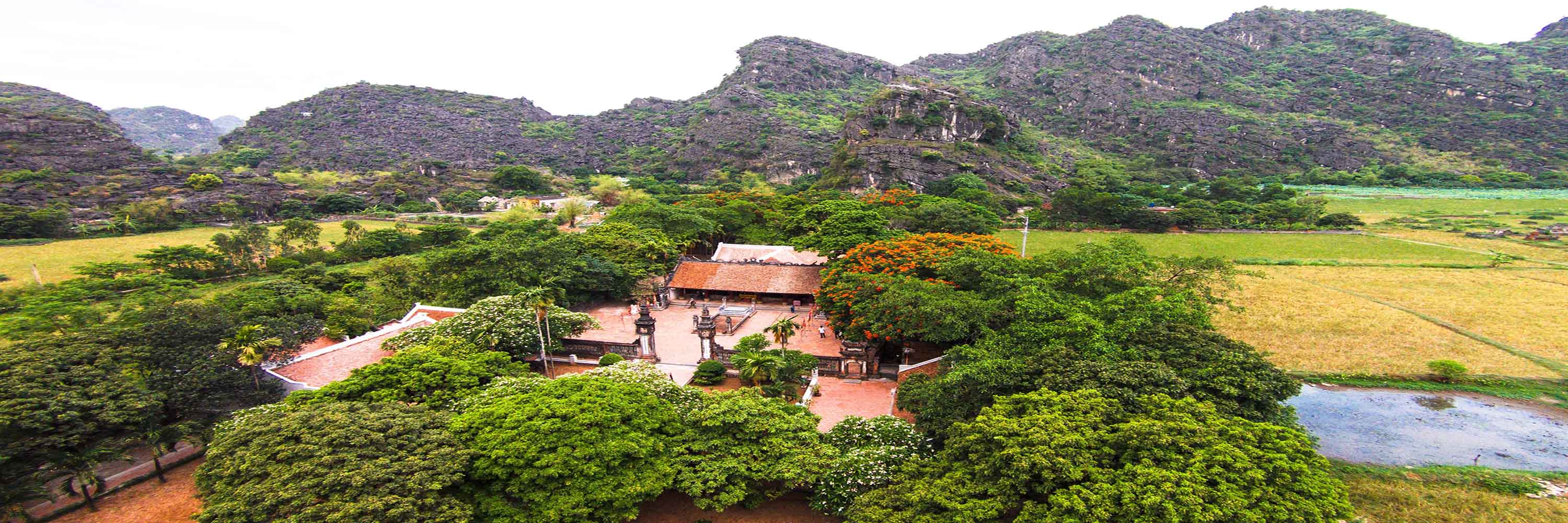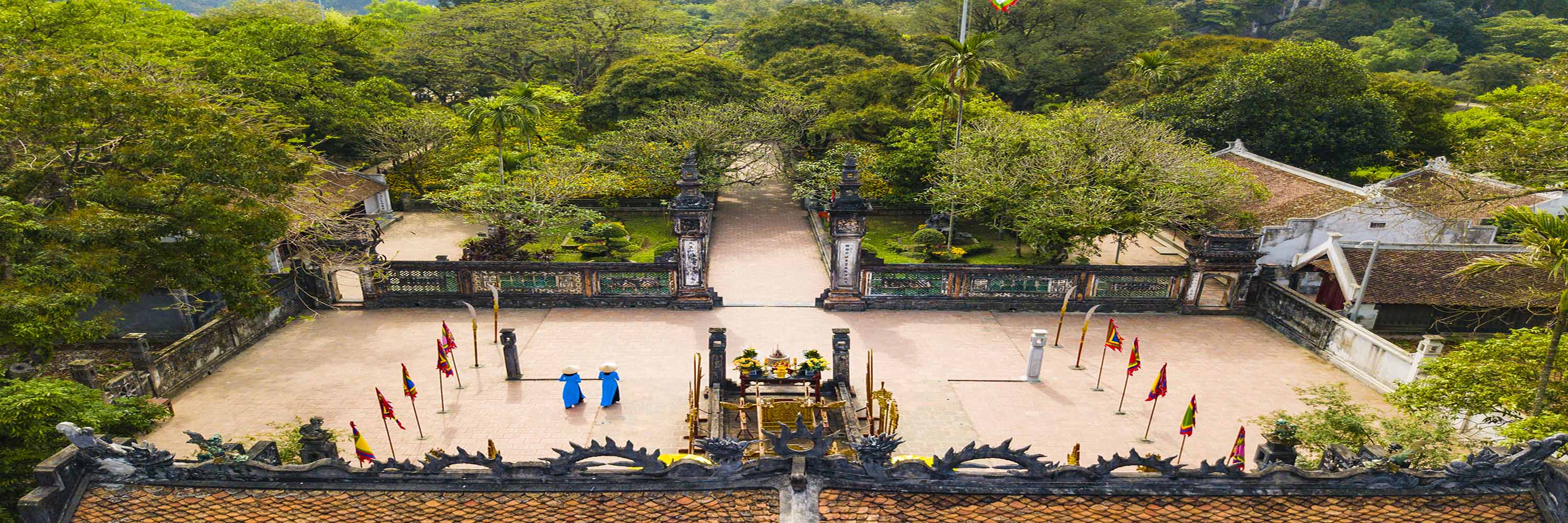Sculpture art on wood and stone materials at Hoa Lu Ancient Citadel
At the beginning of the 17th century, Bui Thoi Trung district's public ceremony for rebuilding two temples of King Dinh and King Le on the old background of the old palace, came in Hoang Dinh 7th year (1606) for carving beer saved. Two temples underwent some major restoration and renovation: In the year of the Dragon (1676), the people of Truong Yen restored two large temples, to the 10th Thanh Thai year (1898), Mr. Duong Duc Vinh (Ba Kenh) ) and the people of Yen Thuong School improve the temple of King Dinh with stone thresholds and the foot of ancient rock.
Although it has spent more than 400 years with many historical ups and downs and events of natural disasters and enemy sabotage, both temples still retain the architectural style of the Late Lê Dynasty in the seventeenth century, with touches Beautiful carving has high value on decorative sculpture art. It is a blessing for the treasure of Vietnamese art heritage. Some antiquities of the ancient capital of Hoa Lu were selected for display at museums such as: Long Sang version of the temple of Dinh emperor on display at the Vietnam Fine Arts Museum; columns of Dinh Lien for carving, square bricks decorated with lotus patterns and phoenix birds, Dai Viet national army tiles ... are displayed at the Museum of Vietnamese History and Ninh Binh Provincial Museum.
On wood material
King Dinh Temple and King Le temple is a national level project, which is directed directly by Bui Thoi Trung district public administration, so the types, sizes of wood and construction workers must be chosen carefully. . Therefore, in both temples the carvings of wooden architecture are preserved almost entirely, most of them are of special value in the sculpture of the seventeenth century - the highest peak in three centuries gold of Vietnamese folk wood carving art (XVII, XVII, XIX centuries).
Right from the inner discipline, foreign students have been watching the decorative carvings on wooden architecture. Although the carvings in the monastic decoration are few but unique, it is the image of "Fairy riding the Dragon", "The person who stabbed the beast" in the interior and exterior of the monastery was worshiped by King Dinh. Confucian symbol "letter", "book", "wine vote", "bag of poetry" of the "talented writer" in the foreign discipline of the temple of King Le. When walking into the temple courtyard visitors will be overwhelmed by the exquisite beauty and vibrant colors of wood sculpture. Especially on the porch of the Le King's temple is a vivid picture showing the artistic talents of the ancient artisans with Truc Hoa Rong, Rong carp, a typical flower image of Lotus to remind about transmission. The theory of birth of King Le. The temple interior carved on wooden architecture is concentrated in Thieu Huong court with subtle hammock layers, especially in the wooden wall separating Thieu Huong and Chinh Cung and Dragon Drive and Dragon decoration decorations.
Techniques of carving on wooden architecture in the temple of King Dinh and King Le are mostly of types: sinking, embossing low - high, puncturing, touching - channel, touching. Besides the style of royal sculpture art (images of long, glass, rules, phoenix, lunar, moon face ...), there are also interwoven improvisational creations of the artist with bold folk nuances. show locality clearly.
Dinh Tien Hoang King Temple is a unique architectural work in the wood carving art of Vietnamese folk artists in the 17th century.
The noticeable feature of architectural carvings here is: are above the rafters, most are horizontal; facing the gate opposite the tourist's view; The color is very vivid with the gold color painted on the temple's interior, the monastery and the paint mix the silt on the temple carved outside. Although the layout is controlled by rafter structure, the designs on wood sculptures are still arranged in many types of molds: round, square, rectangular, rectangular, long running horizontal ... there are also quite a number of free-form layouts.
On stone material
Long sieve (stone collapse) in the temple of King Dinh and King Le was evaluated by art researchers as the most typical in the sculpture of worshiping worship in Vietnam, it is difficult to find where there are collapsed ones. Stone is carved so carefully. Dragon decoration project is used a lot when creating Long sieve with Dragon image on the surface, Dragon flanking both sides. Adopting a decorative pattern on Long sieve that shows the age of Long sieve, art style in each period.
The art of stone sculpture is also shown by ancient artisans on stone steles at two temples; the threshold, the base of the neck and the crest in the temple of King Dinh. In particular, with the talent of shaping the ancient artisans' image, the image of stone rock at King Dinh temple was determined by researchers to be the standard for the symbol of rock art in Vietnam. Therefore, after the Official Dispatch No. 2662 / BVHTTDL-MTNATL dated August 8, 2014 of the Ministry of Culture, Sports and Tourism about not using symbols, mascot products are not suitable for fine customs. Vietnam is sent to ministries, departments, agencies and units, some stone artisans have found the King Dinh temple to study the image of rock art here to re-craft the pure Vietnamese mascot. .
Through the study of sculpture on wood and stone materials at the temple of King Dinh and the temple of Le King to help us move closer to his father, understand the spiritual world as well as the wishes and worries. busy life of the old people. Those are living documents that signal the transformation of aesthetic model, social change in each period.
Article other
Preserve, embellish and promote the cultural and historical values of Hoa Lu ancient capital
12/12/2018
Hoa Lu ancient capital
12/12/2018
To the Truong Yen Festival is a place of converging special cultural features
12/12/2018
Traditional festival of sacred land
12/12/2018
Trang An landscapes and most famous populations
12/12/2018



